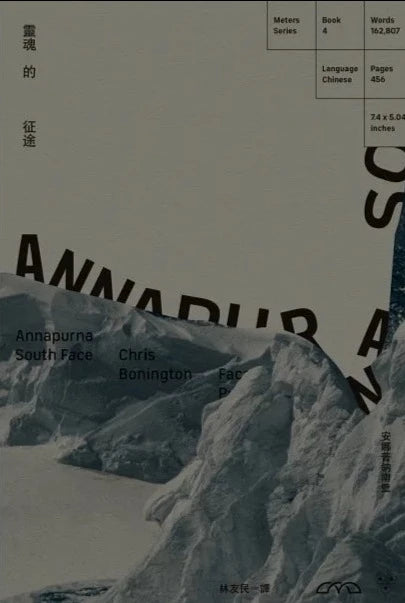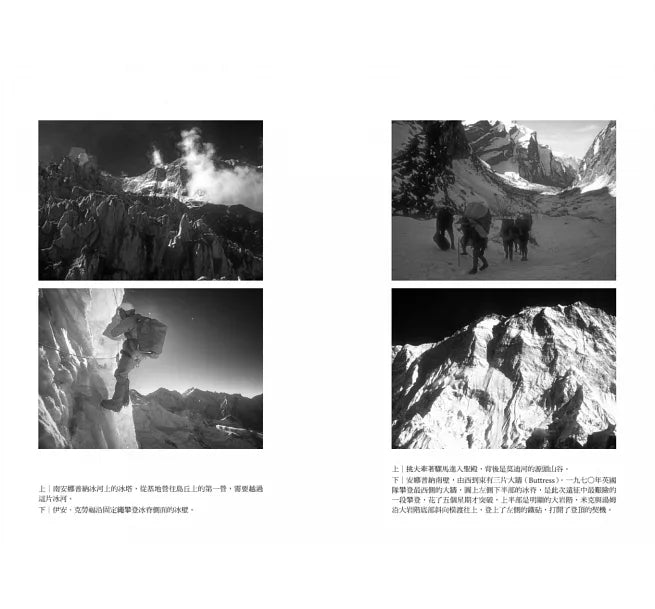1
/
of
3
Journey of the Soul: Annapurna South Face
Journey of the Soul: Annapurna South Face
Regular price
MOP$173.00
Regular price
Sale price
MOP$173.00
Unit price
/
per
Couldn't load pickup availability
In 1970, Chris. Chris Bonington and an expedition team of seven top climbers attempted to climb the south face of Annapurna, the tenth highest mountain in the world, a formidable wall towering in the Himalayas. This extremely steep mountain wall mixed with ice, snow and rock has a vertical drop of nearly 3,600 meters, and the peak altitude is as high as 8,091 meters. Through the excellent planning of the team leader Bonington and the continuous cooperation of the members, this expedition set an important milestone in the history of modern mountaineering and ushered in the era of Himalayan wall climbing in the following decades. Bonington is one of the most important mountaineers of the 20th century. This book was written by him. It describes how this group of outstanding mountaineers, under the test of extreme environments, used all their strength to recover from the imminent defeat of the battle. Solve the numbers and seek victory in danger.
▍The death rate is the highest among the 8,000-meter peaks, and the climbing difficulty exceeds the ice and rock cliffs of Mount Everest.
Before 1970, Bonington was already an outstanding British mountaineer, setting many important records, including the first ascent of the central pillar of Freinet on Mont Blanc, the first British ascent of the North Face of the Eiger, and the first ascent of Patagonia. He was the first to climb the sub-alpine rock tower and participated in the joint expedition to the second peak of Annapurna in 1960.
In 1968, after careful consideration, Bonington finally decided to launch a Himalayan expedition two years later, in 1970, with the goal of a Himalayan wall that had never been conquered and was more difficult than Mount Everest. Annapurna South Face" will also be the first time he takes on the important responsibility of team leader in the expedition.
This large rock wall in northern Nepal is difficult to reach because it is surrounded by peaks. Its height is astonishing, like four Alps stacked on top of each other, and avalanches are constantly scouring it. There are also ice edges, ice cliffs, and large rocks that are difficult to climb. The terrain, height and difficulty far exceed any route that has been climbed in the Himalayas. But in the face of this big wall, Bonington used a calm and rational analysis and believed that it was not impossible to achieve. Starting from gathering the team members, he started step by step to launch this world-famous expedition plan.
▍Eight climbers selected one out of ten thousand, representatives of the "Great Era" of modern climbing
Facing this intimidating high wall, he selected seven mountaineering team members selected from ten thousand, including Nick. He was the former president of the Cambridge University Mountaineering Club and had rich experience in Alpine climbing. Nick Estcourt; Martin who pioneered many of Britain's most difficult climbing routes. Martin Boysen; in John. After Haring's death, Dougal, one of Britain's most outstanding mountaineers, took over as principal of the International Modern Mountaineering School. Dougal Haston; Bonington’s old comrade-in-arms, the kind and selfless Ian. Ian Clough; Mick, who is only 28 years old and has extremely perseverance. Mick Burke; Don. Considered to be the most outstanding all-around British post-war mountaineer. Williams (Don Whillans), and the only American on the team, Tom. Tom Frost. These mountaineers were all the top climbers at the time, but they had very different personalities, and outstanding mountaineers focused more on personal achievements. Therefore, for the team leader, how to get this group of mountaineers to eliminate selfishness, cultivate tacit understanding, and work together to achieve the goal is also a challenge. It's a big challenge.
▍From equipment, food, tactics, on-the-spot response to controlling people's hearts, witness the art and difficulties of expedition dispatching
This expedition team is mainly composed of the leader Bonington and seven climbing members, as well as doctors, base camp managers and other logistics teams. This expedition also includes the TV broadcast team, bringing the total number to 21 people. With the addition of postmen, chefs and local Sherpa porters, the scale is no small matter.
In order to support the entire expedition, everything from equipment, food, funds to medical and communication equipment needed to be carefully planned and purchased in advance. Therefore, the two-month expedition took more than a year to prepare. During this period, Bonington, as the team leader, needed to select climbing team members, prepare a logistical supply system, manage equipment and food, arrange cross-border transportation, negotiate with the Nepali government, and plan climbing plans and schedules... These preparatory tasks were huge. It is trivial, but it is crucial to the expedition. A little carelessness may lead to failure or even death of the team members in a foreign land. During the actual climb, the team leader is also responsible for scheduling the climbing team members, and must understand the physical and mental conditions of everyone and control the morale of the entire expedition team in order to achieve the goal. The heavy responsibility of being a leader is almost as difficult as the actual climb.
"This must be the biggest challenge in my life. On the one hand, the huge scale of the South Face is a difficult problem for mountaineering, but mainly because I have assumed the responsibility of the leader of this expedition. ... If you choose mountaineering as your life The journey, when you serve as a group leader for the first time, is as exciting as the first time you stand on the top of the Himalayas - but it is also just as short."
▍Britain’s greatest achievement since the Everest expedition, the glory and sacrifice of thrilling victory on the edge of failure
After long-distance flights, negotiations with government departments, delays and omissions in shipping and other tests, the expedition team finally reached the Annapurna Circle Valley. Only when they visited this big wall in person did they truly understand the difficulty of climbing this rock wall. In addition, they had to pass through broken glaciers before climbing, full of hidden crevices, seracs that could collapse at any time, and large-scale avalanches. potential threats, everyone is on a thin line between life and death.
But under the leadership of Bonington, the expedition team used unprecedented teamwork and the superb skills of each climber to finally climb the South Face of Annapurna in two full months. During this period, they faced many crises and dilemmas, and the team also had fierce disputes over strategies and tasks. Faced with this mountain, the fragility and reality of human nature were fully exposed. But with team members performing their respective duties, the goal was finally achieved. However, before the expedition was about to end, a tragedy happened that broke everyone's heart...
▍Open the next chapter of Himalayan mountaineering, the best expedition documentary classic in mountain literature
The expedition is hailed as Britain's most important climbing achievement since the Everest expedition in 1953 and a turning point in Himalayan mountaineering. Since then, the goal of climbers has changed from reaching the summit to challenging difficult routes, opening the next chapter in Himalayan mountaineering. This was also the first time that British people could participate in an expedition climbing almost simultaneously through television broadcasts, which aroused strong social concern at the time. After returning home, Bonington wrote the detailed process of the expedition into this book, which is still considered the best documentary classic of the expedition in mountain literature and is irreplaceable.
View full details
▍The death rate is the highest among the 8,000-meter peaks, and the climbing difficulty exceeds the ice and rock cliffs of Mount Everest.
Before 1970, Bonington was already an outstanding British mountaineer, setting many important records, including the first ascent of the central pillar of Freinet on Mont Blanc, the first British ascent of the North Face of the Eiger, and the first ascent of Patagonia. He was the first to climb the sub-alpine rock tower and participated in the joint expedition to the second peak of Annapurna in 1960.
In 1968, after careful consideration, Bonington finally decided to launch a Himalayan expedition two years later, in 1970, with the goal of a Himalayan wall that had never been conquered and was more difficult than Mount Everest. Annapurna South Face" will also be the first time he takes on the important responsibility of team leader in the expedition.
This large rock wall in northern Nepal is difficult to reach because it is surrounded by peaks. Its height is astonishing, like four Alps stacked on top of each other, and avalanches are constantly scouring it. There are also ice edges, ice cliffs, and large rocks that are difficult to climb. The terrain, height and difficulty far exceed any route that has been climbed in the Himalayas. But in the face of this big wall, Bonington used a calm and rational analysis and believed that it was not impossible to achieve. Starting from gathering the team members, he started step by step to launch this world-famous expedition plan.
▍Eight climbers selected one out of ten thousand, representatives of the "Great Era" of modern climbing
Facing this intimidating high wall, he selected seven mountaineering team members selected from ten thousand, including Nick. He was the former president of the Cambridge University Mountaineering Club and had rich experience in Alpine climbing. Nick Estcourt; Martin who pioneered many of Britain's most difficult climbing routes. Martin Boysen; in John. After Haring's death, Dougal, one of Britain's most outstanding mountaineers, took over as principal of the International Modern Mountaineering School. Dougal Haston; Bonington’s old comrade-in-arms, the kind and selfless Ian. Ian Clough; Mick, who is only 28 years old and has extremely perseverance. Mick Burke; Don. Considered to be the most outstanding all-around British post-war mountaineer. Williams (Don Whillans), and the only American on the team, Tom. Tom Frost. These mountaineers were all the top climbers at the time, but they had very different personalities, and outstanding mountaineers focused more on personal achievements. Therefore, for the team leader, how to get this group of mountaineers to eliminate selfishness, cultivate tacit understanding, and work together to achieve the goal is also a challenge. It's a big challenge.
▍From equipment, food, tactics, on-the-spot response to controlling people's hearts, witness the art and difficulties of expedition dispatching
This expedition team is mainly composed of the leader Bonington and seven climbing members, as well as doctors, base camp managers and other logistics teams. This expedition also includes the TV broadcast team, bringing the total number to 21 people. With the addition of postmen, chefs and local Sherpa porters, the scale is no small matter.
In order to support the entire expedition, everything from equipment, food, funds to medical and communication equipment needed to be carefully planned and purchased in advance. Therefore, the two-month expedition took more than a year to prepare. During this period, Bonington, as the team leader, needed to select climbing team members, prepare a logistical supply system, manage equipment and food, arrange cross-border transportation, negotiate with the Nepali government, and plan climbing plans and schedules... These preparatory tasks were huge. It is trivial, but it is crucial to the expedition. A little carelessness may lead to failure or even death of the team members in a foreign land. During the actual climb, the team leader is also responsible for scheduling the climbing team members, and must understand the physical and mental conditions of everyone and control the morale of the entire expedition team in order to achieve the goal. The heavy responsibility of being a leader is almost as difficult as the actual climb.
"This must be the biggest challenge in my life. On the one hand, the huge scale of the South Face is a difficult problem for mountaineering, but mainly because I have assumed the responsibility of the leader of this expedition. ... If you choose mountaineering as your life The journey, when you serve as a group leader for the first time, is as exciting as the first time you stand on the top of the Himalayas - but it is also just as short."
▍Britain’s greatest achievement since the Everest expedition, the glory and sacrifice of thrilling victory on the edge of failure
After long-distance flights, negotiations with government departments, delays and omissions in shipping and other tests, the expedition team finally reached the Annapurna Circle Valley. Only when they visited this big wall in person did they truly understand the difficulty of climbing this rock wall. In addition, they had to pass through broken glaciers before climbing, full of hidden crevices, seracs that could collapse at any time, and large-scale avalanches. potential threats, everyone is on a thin line between life and death.
But under the leadership of Bonington, the expedition team used unprecedented teamwork and the superb skills of each climber to finally climb the South Face of Annapurna in two full months. During this period, they faced many crises and dilemmas, and the team also had fierce disputes over strategies and tasks. Faced with this mountain, the fragility and reality of human nature were fully exposed. But with team members performing their respective duties, the goal was finally achieved. However, before the expedition was about to end, a tragedy happened that broke everyone's heart...
▍Open the next chapter of Himalayan mountaineering, the best expedition documentary classic in mountain literature
The expedition is hailed as Britain's most important climbing achievement since the Everest expedition in 1953 and a turning point in Himalayan mountaineering. Since then, the goal of climbers has changed from reaching the summit to challenging difficult routes, opening the next chapter in Himalayan mountaineering. This was also the first time that British people could participate in an expedition climbing almost simultaneously through television broadcasts, which aroused strong social concern at the time. After returning home, Bonington wrote the detailed process of the expedition into this book, which is still considered the best documentary classic of the expedition in mountain literature and is irreplaceable.






